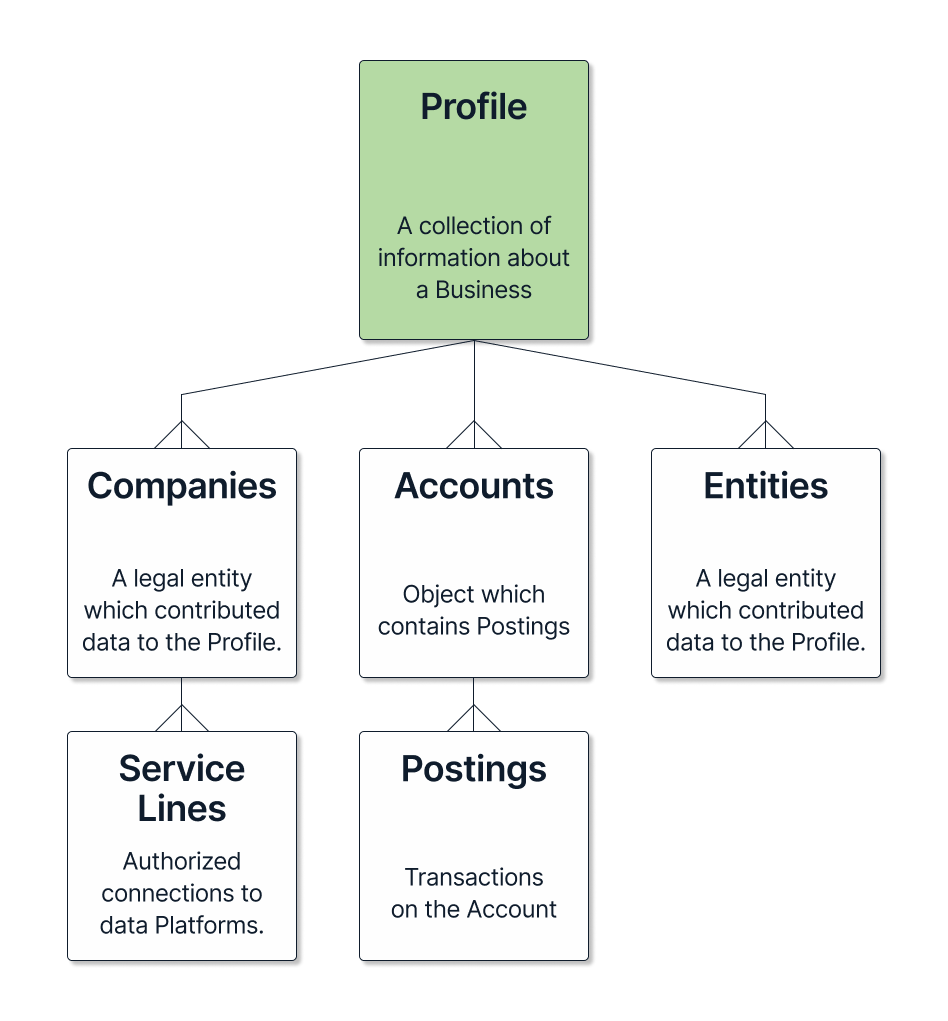How Profiles are Structured
A Profile is a collection of information on a business. There are several related resources which will drive much of the interaction with profiles.

Companies
Companies are the legal entities associated with a Profile. When a Profile is composed of many connections to data sources, it may be the case that those data sources are associated with different entities of that business. This is particularly useful for accounting for commercial organizations and businesses that use legal entities to isolate investments (e.g. real estate).
Service Lines
Service Lines are the authorized connections to Platforms associated with this profile. Users create and patch Service Lines via Basis Connect. For example, a user may authorize access to their company's Silicon Valley Bank accounts. This would constitute one service line on the Profile.
It may be useful to keep track of which Services Lines a business is using to populate their Basis Profile - perhaps to communicate with users about the freshness of their data or to better understand whether a business has connected to all of their relevant Platforms.
Service Lines will be the source of Connected Accounts. A Service Line will have accounts which are reflected in the Profile's Chart of Accounts.
Entities
The Entities resource describes all businesses and individuals related to the Profile. This includes Users, Payees, and Addressees (i.e. the business or individual to which account statements are addressed).
Entities are used used to understand the relationships between various parties on the Profile. Fraud prevention is a common use case. For example, this may include verifying that the business addressee on the Service Line is, indeed, the business onboarding to your application.
Accounts
Accounts are objects for storing Postings. They can either be "Connected" or "Notional":
| Account classification | Source |
|---|---|
| Connected | Direct observation from Service Lines |
| Notional | a) Inferred from the counterparties on Postings from Connected Accounts b) Aggregate Accounts to generate the Chart of Accounts hierarchy |
Connected Accounts
Connected Accounts are directly associated with a Service Line. For Service Lines at banks, Connected Accounts will likely be of types checking, savings, money market, or similar. They will have Account masks and associated Payment Credentials for initiating transfers. Following the example in the Service Line section above, the Silicon Valley Bank Service Line could be associated with several checking Accounts and a money market Account.
Notional Accounts
Basis maintains a double-entry system. Notional Accounts are created and maintained to balance postings observed in Connected accounts. Notional Accounts are also created to represent the hierarchical structure of the Chart of Accounts. A couple of examples of Notional Accounts will illustrate this best:
- A Profile's checking accounts will be nested under a
cash and cash equivalentsAccount.cash and cash equivalentsis a Notional account. - A business which transacts with the law firm "Goodwin Proctor" will have a
goodwin proctorNotional Account, where transactions with the law firm are stored.
Notional accounts are very useful when analyzing a business. They eliminate the need to do aggregation on accounts of similar types. This enables, for example, easily seeing a cash balance history by querying the cash Account or collecting all rent expenses by building a Postings report against the rent expense Account - even if the counterparty paid for rent has changed.
For more detail, see Types of Accounts on a Profile.
Postings
Postings are transactions which relate to an Account. Connected Accounts will have postings which are observations from the Service Line. Notional Accounts will have postings which are inferred from an observation. Continuing on the example above with rent payments, the rent payment transaction in the connected bank Account will be a direct observation from the Service Line with the bank and the transaction in the notional rent expense Account will be inferred from the connected account.
Updated 10 months ago